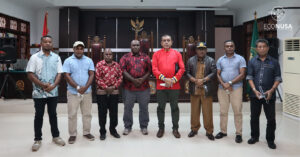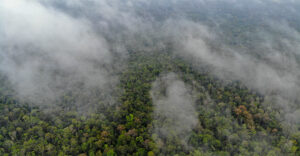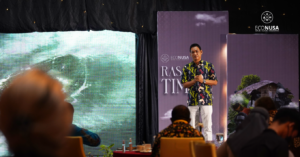
Indonesia is deemed the biggest archipelagic country in the world with 108,000 kilometers coastal lines. It is no wonder then that the fisheries and maritime resources in Indonesia are considered the underwater ‘paradise’. However, this fact does not go in line with the reality that being a fisherman is not an economically promising profession. Let alone, the gap of information access has every so often made fishermen fail to get a decent living from their fishery commodity.
Based on the 2017 Maritime and Fisheries Ministry Annual Report, fisherman income always increases annually ranging from 2014-2017. However, the fisherman is always fluctuating. For instance, in 2014, the average income of fisherman is IDR 2.15 million per month. In 2015, it dropped to IDR 1.9 million per month. Then, their average income rose again in the following two years into IDR 2.1 million and IDR 2.7 million per month respectively.
On the other side, fishermen have once drastically dropped. For a decade, from 2003-2013, fisherman household fell by 50 percent from 1.6 million into 800 households. This figure turns to be ironical fact along the coastal lines in the maritime country.
Distribution chain of fishery commodity is too long to reach the consumer. The condition has brought about significant pricing gap from the upstream to downstream distribution of the commodity. The profit only sides with the collector amidst the people who relies simply on information.
Technology utilization for fisherman
Considering the fact, Indraka Fadhillah in collaboration with Farid Naufal Aslam and Utari Octavianty intended to create a more open economic activities on the coastal areas. They made a digital platform that enables fisherman to get broader markets. They established PT. Aruna Jaya Nuswantara in 2016.
Read also: New Normal on Indonesian Ocean
“Coastal (economic activity) could actually be open to wider scope of public and the distribution could take place at the coast areas. We could use information technology,” said Indraka, the Co-Founder and Chief Operating Officer of Aruna, to EcoNusa.
East Kalimantan Province was the first spot for Aruna to help empower the fishermen in Balikpapan Regency. Unlike fishermen in Java Island, the spot was selected due to the large number of traditional fishermen with minimum market access to sell their fish. The second selected spot was Berau Regency with similar condition to that of in Balikpapan. There have been 16 locations so far with more than 300 fishermen across Indonesia as the partners of Aruna.
Aruna worked in collaboration with local peoples to record the transaction with fisherman due to the fact that not all fishermen were accustomed to using such digital platform. Aruna named them local heroes from the fisherman household. They do not only act as the middleman of Aruna and fishermen, the local heroes also have responsibility to develop fisherman capacity to maintain quality of the catches. Leadership is deemed the main prerequisite as they should be responsible in every location and should stand head to head with the fishermen.
The fishermen transaction is jotted down and recorded in a data server which is integrated with e-commerce catalogue and marketplace. There are 24 types of fisheries products on Aurna’s display and distributor in various places.
The information technology has made the fishery commodity saleable to international markets. Typing “fish”, “buying fish” on the search engine will be connected to Aruna fishery products. “From this point, they are aware that fishery trading in Indonesia has been online,” said Utari, the Director General of Aruna. She believed that information technology has enabled Aruna products to reach buyers from America, China and Singapore.
“For the time being we are not open to public. Because we cannot supply all of them yet. We have just started digitalizing the power of supply side and fishermen data,” added Indraka.
Read also: Sustainable Fisheries and Maritime Less Prioritized in Job Creation Bill
The presence of Aruna in various places has become “thorn” to the system of fishery distribution that has existed for a long time. The information technology made the market price traceable to Aruna in many places. Hence, the purchasing price of fishery yields offered to the fishermen grows higher than the normal pricing. Such a condition cut off “the pie” that used to benefit the collectors at various levels.
Consequently, there was friction involving Aruna and the collector. The collectors lost their customers given the fact that they could hardly catch up the price offered by Aruna to the fishermen. “All fishermen sell theirs to us. The collectors eventually came to us and asked us to go. We invited them to collaborate with us. They can sell theirs to us. They are happy. They need not to be busy delivering fish with suspended payment,” said Indraka.
As to Indraka, the collector at first level who is directly in touch with the fisherman does not take much profit from the fisherman. The price margin with too much gap happens in the middle of the distribution chain. The collector at first level, Indraka said, also plays their roles as ‘heroes’ to the fishermen by providing assistance to fishermen and manage the fishery products.
Capacity development for fisherman
In addition to price margin, the capacity development for fisherman has become one of homework to tackle promptly. It commonly happens to the fishermen on the remote areas or isolated out of town. Based on Aruna’s experiences, such a condition happens for instance in Togean Island, Tojo Una-Una Regency, Central Sulawesi Province.
Read also: Never Let Fishermen Down due to Corona
At the time, the fishermen caught fish as much as possible to earn more income. They had not recognized yet the criteria of exported fish with high selling price. On a certain occasion, Aruna found grouper fish (kerapu sunu/plectropomus leopardus) on the same scale as other type of grouper fish (kerapu lumpur/epinepheus coioides).
“The kerapu sunu price can be IDR 400,000 worth per kilogram. During Imlek (Chinese New Year), the price could skyrocket up to IDR 1 million per kilogram. Alas, the local fishermen had no idea about it. They just mixed the bad quality of grouper fish. There are some places with the fishermen giving the same prices. Then the collector picked them up and brought them to the middle distribution chain that enjoy the profit margin. There are many similar cases in Papua, West Papua, Maluku, North Maluku,” said Indraka.
Indraka expected that fisheries and maritime business players spread all over many regions, intead of spotted on some certain locations. Besides, the open information access could make price margin profitable to many parties. Unlike what happens now, it is simply benefiting certain group of parties. Therefore, market will have more open competition. This will provide positive impact to the fishermen because they will have various pricing of their various catches.
Editor: Leo Wahyudi




